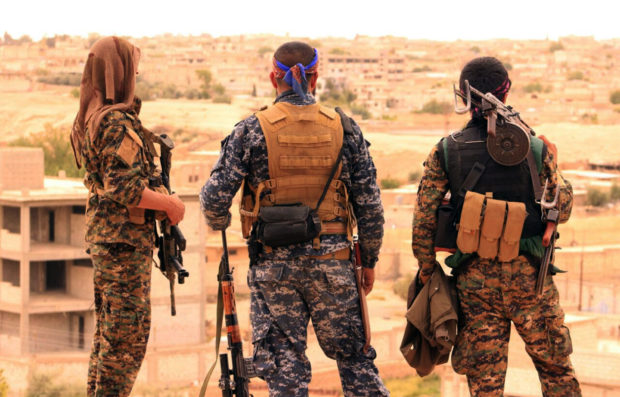
This April 30, 2017, file photo, provided by the Syrian Democratic Forces (SDF), shows fighters from the SDF looking toward the northern town of Tabqa, Syria. US-backed Syrian forces have launched their attack on the Islamic State group’s de facto capital of Raqa, in northern Syria, just as the jihadist group is making its last stand in Mosul in neighboring Iraq. (Syrian Democratic Forces, via AP)
Faced with an onslaught of weaponized drones, mortar rounds and snipers, US-backed fighters in Syria’s Raqa say the cover of night is a good ally against Islamic State group jihadists.
Members of the Syrian Democratic Forces (SDF) are battling to oust the extremists from the northern city after breaking into its first neighborhood last week.
After piercing into and taking the southeastern district of Al-Meshleb, the SDF fighters are now advancing towards the Old City.
In the daylight hours, at an apartment in Al-Meshleb, the Kurdish-led fighters catch some rest or sip tea after a night on the front line at the edge of the city’s historic center.
“We prefer to fight in the dark as we have thermal binoculars and weapons equipped with night vision scopes,” says 20-year-old Kawa, giving his nom de guerre.
“There was fighting last night but not for long. The jihadists withdrew rapidly, faced with our attacks,” says the cleanly shaven SDF fighter.
On the flat’s balcony, he tries to liaise on a walkie-talkie with a fellow fighter at the front, but on the other end his colleague comes under fire.
“(The) IS is attacking our positions with mortar fire. I’ll get back to you when the bombardment stops,” the fighter on the other end of the line says.
In Al-Meshleb, SDF fighters sometimes run into shops and houses to avoid IS weaponized drones.
Tolhildan Botan points to one such small unmanned aircraft at the foot of a wall in the district, which he says fellow fighters had shot down.
“This is the kind of drone they use to target gatherings of fighters or military vehicles. Sometimes they even target civilians,” says the SDF fighter, who did not give his age.
‘Faster’ at night
Baran Hassake, a fellow fighter, says battling the jihadists is easier at night.
“We advance and gain ground faster and they struggle to respond to our attacks,” the 18-year-old says, his head wrapped in a red scarf embroidered with green flowers.
“We know now their tactics,” Hassake says, boasting of knowledge acquired by the SDF, who have recaptured several former IS bastions in Syria.
Empty mortar rounds litter the ground, while the corpses of jihadists at times can be seen in the rubble of destroyed buildings.
The US-led coalition backing the SDF has also been intensifying its air strikes at night, SDF commanders and the Syrian Observatory for Human Rights monitor say.
The United Nations on Wednesday warned of the danger for civilians of “excessive” air strikes on the city, where it says around 160,000 remain.
The SDF has retaken three neighborhoods since entering the city on June 6, including Al-Senaa next to the Old City on Thursday.
This latest advance will allow SDF fighters to launch an assault on the Old City in Raqa’s densely populated center, which contains key IS positions.
On another balcony in Al-Meshleb, Mesaab al-Hussein looks out across Al-Senaa and towards the historic city walls of ancient Raqa, which date back to the Abbasid caliphate.
From 796 to 809, the powerful caliph Harun al-Rashid transferred the capital of his empire from Baghdad to Raqa, which sat at the crossroads of key trade routes.
“The SDF are nearing a part of the wall known as Baghdad gate,” Hussein says.
Pointing to an IS flag in the distance, he adds: “We will liberate the entire city.” JPV/rga